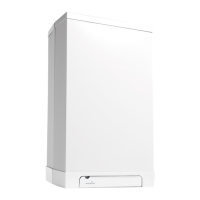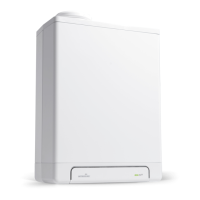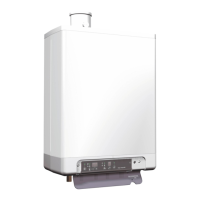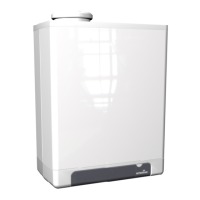Always fill the condensate trap with water and
place it on the boiler before powering up the
boiler.
For filling the condensate trap the hose between
de trap and the PRV has to be removed (trap
side). Make sure the hose is re-mounted after
filling the condensate trap.
Not placing or filling up the condensate trap may
cause flue gases to come into the installation
room and can lead to dangerous situations!
.
The condensate discharge system, pipework and fittings must be made of
plastic. No other materials may be used. The discharge duct must have a
gradient of 5 – 20 mm/m throughout its length. Condensate discharge via the
gutter is not allowed given the risk of frost and the possible damage to
materials
a. Internal stack pipe (see diagram)
b. Gully
c. Condensate discharge from boiler
d. Servicable waste trap
e. 5 – 20 mm/meter
f. > 100 mm
g. > 110 mm
h. > 450 mm
If an externally-run condensate drainage pipe is used the following measures
should be adopted to prevent freezing:
- the pipe should be run internally as far as possible before going externally,
the pipe diameter should be increased to a minimum of 30mm ID (typically
32mm OD) before it passes though the wall;
- the external run should be kept as short as possible, taking the most vertical
route possible to the discharge point, with no horizontal sections in which
condensate might collect;
- the external pipe should be insulated using suitable waterproof and
weatherproof insulation (‘’Class O’' pipe insulation is suitable for this purpose);
- the use of fittings, elbows etc should be kept to a minimum ans any internal
‘’burrs’’ on cut pipework should be removed so that the internal pipe section is
as smoooth as possible.
For more information about preventive measures against freezing please visit
the HHIC website http://www.centralheating.co.uk/checklists/frozen-
condensate-pipes.

